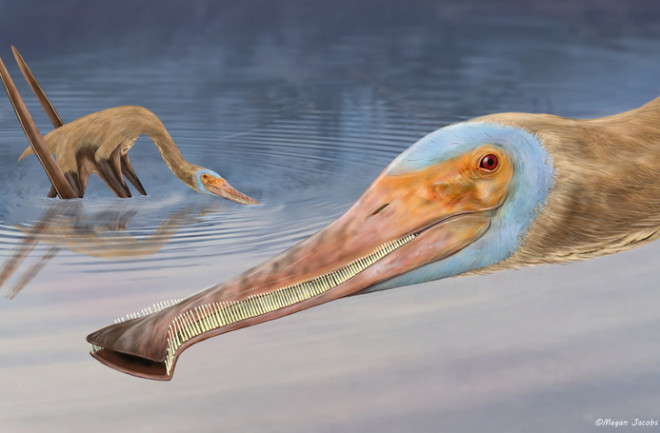The first thing to you'll notice about this pterosaur is its smile. According to a new paper published in Paläontologische Zeitschrift (PalZ), researchers recently identified this strange species, which had 480 of thin, hooked teeth in its flared, flat jaws.
Toothy Pterosaur
Since the identification of the first pterosaur fossils in the formations of limestone in Germany in the 1700s, paleontologists have found hundreds of separate species of these ferocious flyers, all with their own shapes, sizes and lifestyles.
Some were small, while others weren’t. Some possessed wide wings, and some possessed slimmer, slenderer ones. Some were stuck with an awkward slouching posture, whereas others stood upright and walked, waded and swam whenever they weren’t soaring through the sky. And while some of these almost-dinosaurs benefitted from an abundance of tiny teeth, others boasted a smattering of big ones or no teeth at all.
Read More: Newly Discovered Dinosaur Likely Resembled a Duck
Now, a team of paleontologists has found another pterosaur species in the same formation of limestone as the first, though the new specimen has a smile unlike any other.
“The jaws of this pterosaur are really long and lined with small fine, hooked teeth, with tiny spaces between them,” says David Martill, a study author and a paleontologist from the University of Portsmouth’s School of the Environment, Geography and Geosciences, according to a press release. “And what’s even more remarkable is some of the teeth have a hook on the end, which we’ve never seen before in a pterosaur ever.”
According to the team, this abundance of hooked teeth helped the animal snatch shrimp and other small species out of the shallows of Late Jurassic lagoons and lakes, around 164 to 145 million years ago.
“These small hooks would have been used to catch the tiny shrimp the pterosaur likely fed on — making sure they went down its throat and weren’t squeezed between the teeth,” Martill says in the same press release.
A Species With A Smile
Though the fossil was found in a fragment of the finely layered limestone, which was split into 17 separate pieces, the specimen was surprisingly well preserved. In fact, though the fragile skeletons of pterosaurs seldom withstand the test of time, this fossil was largely intact, with working joints, well-preserved teeth and the traces of soft tissues.
“This was a rather serendipitous find of a well-preserved skeleton with near perfect articulation, which suggests the carcass must have been at a very early stage of decay,” Martill adds in the release. “It must have been buried in sediment almost as soon as it had died.”
Read More: Massive Ostrich-Like Dinosaurs Once Lived In Mississippi
According to the team, the teeth were thin, tapering into small hooks, or “hooklets.” And, while there were no teeth at the front of the pterosaur’s bill, which was similar to a spoon with its flat, flared structure, there were about 480 teeth trimming its sides, stretching all the way to the back of the beak.
This, the paleontologists say, allowed the species to filter feed while wading or swimming, separating tiny shrimp out of big sips of water. It also served as the inspiration for the formal terminology for the species, Balaenognathus maeuser, which was intended to invoke the similar filter feeding strategy of the bowhead whale.
Ultimately, only one other pterosaur boasts a bigger set of teeth than B. maeuser. But while the beak of this species was armed with around 1,000 teeth, they took on a much more standard morphology, being short and stubby in the upper bill and long and straight in the lower one.

